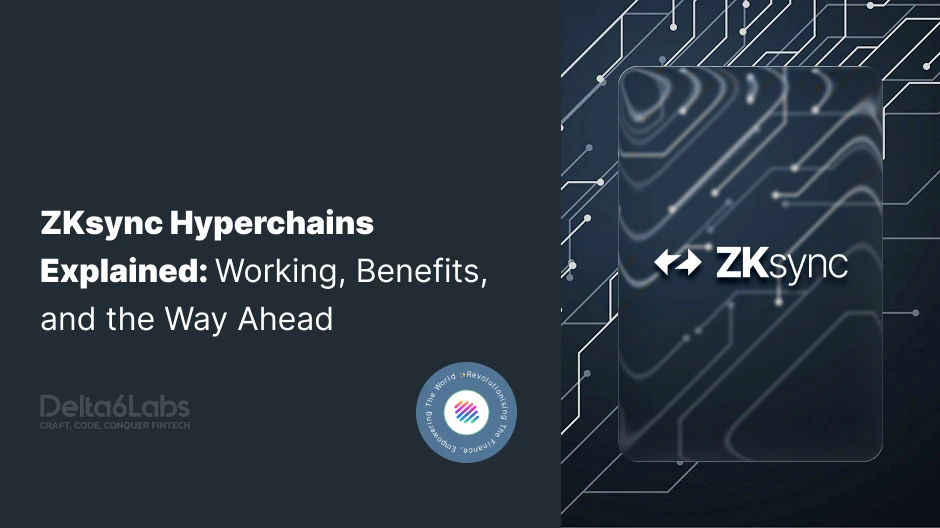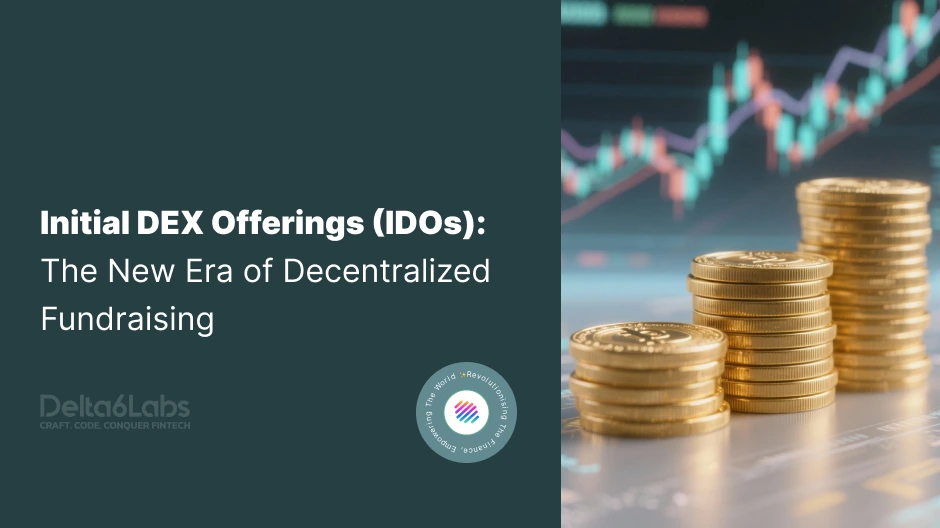ZKsync Hyperchains Explained: Working, Benefits, and the Way Ahead
Table of Contents
Key Takeaways
- ZKsync Hyperchains are here to make building and running Layer-3 blockchains a lot simpler. They run on ZKsync Era and tap into Ethereum’s security, speed, and flexibility, but each Hyperchain stands on its own—its own rules, governance, even its own tokens.
- They all stay linked through zk-rollups, so you get the best of both worlds: independence and connection.
- Developers can launch as many Hyperchains as they need, all talking to each other, without worrying about slowdowns or crazy gas fees. That’s what real scalability looks like.
- Zero-knowledge proofs keep transactions fast and cheap, but also secure and open.
- Moving assets between Hyperchains feels seamless now, so the whole ecosystem just works together better. It’s a multi-chain world, but everything’s still connected.
The blockchain landscape has been changing at a mind-boggling rate over the past decade and as a result new ideas like Decentralised Finance (DeFi), tokenized ownership and on chain governance have been making huge strides in getting out there to the masses. Ethereum, the pioneer of smart contract platforms, is at the centre of all this, but as its popularity has grown so too have its pain points. Issues like sky high gas fees, a lower throughput than desired and congested networks have become major barriers to getting more people on board.
To tackle these problems, companies are starting to think up Layer-2 scaling solutions, and among them , ZKsync, a project created by Matter Labs, is definitely one to watch . Built using zero knowledge rollups (zk-rollups), ZKsync manages to give your throughput and cut down costs while still keeping all the security that Ethereum has to offer.
Now ZKsync is taking things even further with something called Hyperchains, a framework that lets anyone create their own super customisable, and fully sovereign blockchains, or what are more familiarly known as Layer-3s, built right on top of ZKsync Era. And if things go as planned, these Hyperchains are going to change the way scalability, decentralisation, and interoperability all work together in the world of Web3 for good.
About ZKsync
ZKsync is a Layer-2 scaling solution for Ethereum that bundles thousands of transactions into a single, super secure cryptographic proof , gets that proof checked on Ethereum’s mainnet and all that’s left is for Ethereum to give its thumbs up, reducing network congestion, slashing transaction fees and keeping the same level of trust and security that we all love with Ethereum.
After the launch of ZKsync Era the platform was fully certified for EVM compatibility so developers can easily move or deploy existing Ethereum smart contracts without breaking a sweat.
What are ZKsync Hyperchains?
ZKsync Hyperchains are basically a whole new level for ZKsync’s ecosystem. They let you create your own little blockchain, sort of like a Layer-3, but built on top of ZKsync Era.
A Hyperchain is one of those infinite blockchains that all link together, but are still kept safe by Ethereum through some pretty cool technology called zk-rollup. The best part is each one can be tweaked to fit the needs of a particular app or use case, allowing you to decide how it’s governed, what tokens are used, and even how it executes. To break it down a bit:
- Think of Hyperchains as their own separate blockchains
- Powered by ZKsync is what makes them secure with zero-knowledge proofs
- Anchored to Ethereum means its not just some island unto itself, but still a part of that decentralised ecosystem
All of this lets you scale as much as you like without worrying about losing any of that precious decentralisation or security. ZKsync Hyperchains represent a giant leap forward for Ethereum. They’re the key to solving that whole problem of getting blockchain to scale without sacrificing any of the good stuff.
How Do ZKsync Hyperchains Work?
Hyperchains are built on ZKsync’s Layer-2 framework but operate as Layer-3 chains. Here’s how they function:
- Deployment of Hyperchains: Developers can create their own blockchain in the form of a ZKsync Hyperchain. This chain can have its own validator set, rules of governance, or token economy.
- Zero-Knowledge Proofs: Transactions executed on a Hyperchain are compressed into the form of zero-knowledge proofs. These proofs are submitted to ZKsync Era, which in turn connects them to Ethereum.
- Interoperability: Hyperchains are designed in such a way that they can interact seamlessly with each other. A transaction on one Hyperchain can quickly move to another which promotes cross-chain communication.
- Customized: Each Hyperchain can be moulded as per the needs of individuals, such as, high-frequency trading, gaming, enterprise apps, or DeFi.
- Enhanced Security: Although all Hyperchains are independent, they provide Ethereum’s security guarantees via ZKsync’s rollup framework.
This architecture ensures infinite scalability, flexibility, and security, something Layer-1 blockchains alone cannot achieve.
Benefits of ZKsync Hyperchains
Here are the benefits of ZKsync Hyperchains:
Enhanced Scalability
ZKsync Hyperchains empower developers to launch a large number of blockchains as per the need, removing throughput limitations which further promotes mass adoption.
Cost Efficient
Transactions are compressed into zk-proofs to bring down the overall costs as compared to Ethereum’s mainnet fees.
Security of Ethereum
Although these are being Layer-3 solutions, Hyperchains rely on Ethereum’s security through ZKsync proofs to avoid the centralization risks of sidechains.
Flexibility
Hyperchains allow full customization, developers can set execution logic, token models, or governance systems tailored to their applications.
Interoperability
Unlike isolated blockchains, Hyperchains can easily interact with one another, creating a network of blockchains instead of fragmented silos.
User-Friendly Experiences
End users get benefitted from faster transactions, lower fees, and seamless interaction across multiple chains, which further improves Web3 adoption.
Technical and Operational Challenges
Although ZKsync Hyperchains have many benefits, but they also face challenges:
- Running sovereign chains isn’t simple, you need serious technical chops to pull it off.
- Hyperchains are still pretty fresh, so the ecosystem’s still taking shape and developers are figuring things out as they go. And let’s be real, there’s some tough competition out there.
- Polygon Supernets, Avalanche Subnets, and Cosmos Zones all offer solid options. Plus, breaking down Layer-3 concepts for users isn’t exactly easy right now.
ZKsync Hyperchains vs Other Scaling Solutions
Hyperchains are not the only approach to scalability, as there are several other players in the market as well, including:
- Polygon Supernets: Similar concept, but Polygon relies more heavily on sidechains and validators.
- Avalanche Subnets: Offer sovereign chains but require independent validator sets and don’t anchor to Ethereum.
- Cosmos Zones: Enable sovereign chains with interoperability but rely on Cosmos Hub security, not Ethereum.
ZKsync Hyperchains stand out for their zk-proof security model, ensuring Ethereum-level security while offering infinite scalability.
Use Cases of ZKsync Hyperchains
Hyperchains can power a wide variety of industries and applications:
DeFi Platforms
Decentralized finance apps can launch dedicated Hyperchains to handle high volumes of trades and lending without Ethereum congestion.
Gaming and Metaverse
Game developers can create chains optimized for NFTs, in-game assets, and microtransactions, offering near-instant settlement and minimal fees.
Enterprise Solutions
Corporations can deploy private or permissioned Hyperchains for supply chain tracking, finance, or data integrity, while still interoperating with public chains.
NFTs and Marketplaces
Dedicated Hyperchains can support NFT minting and trading at scale, lowering costs for artists and collectors.
Payment Networks
Payment-specific Hyperchains can process millions of transactions per second for micro-payments, cross-border transfers, and remittances.
ZKsync Hyperchains: The Road Ahead
In the coming years, we can probably look forward to:
- More big players adopting Hyperchains – that means enterprises, DeFi protocols, gaming projects, all that jazz
- Better tools for developers so they can get their Hyperchain up and running in half the time
- Multi-chain bridges popping up so that different chains can finally talk to each other properly
- Other ecosystems deciding to take a page out of our book, either to team up or compete
If all this takes off, ZKsync Hyperchains could end up being the backbone of Web3 scalability, making Ethereum the go-to settlement layer for the whole global blockchain economy.
Conclusion
ZKsync Hyperchains are changing the game for blockchain scalability. They let you spin up your own customizable, endlessly scalable chains, all anchored to Ethereum. That means a lot of the headaches people face with Web3 adoption just melt away. If you’re a business, or enterprise wanting to tap into blockchain technology, ZKsync Hyperchains open the door to building apps that are scalable, secure, and play well with others.
At Delta6Labs, one of the leading blockchain development company, help businesses to build custom solutions on ZKsync Era and Hyperchains, whether you’re launching a new DeFi protocol, an NFT platform, or something at the enterprise level.
Frequently Asked Questions
Disclaimer:
The information on this blog is for knowledge purposes only. The content provided is subject to updates, completion, verification, and amendments, which may result in significant changes.
Nothing in this blog is intended to serve as legal, tax, securities, or investment advice of any investment or a solicitation for any product or service.






